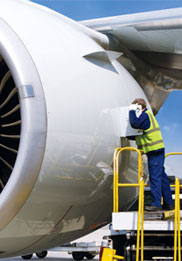

Efficient, dependable ramp operations not only directly affect passengers’ satisfaction with an airline, but they also offer economic benefits, particularly for short-haul carriers (see preceding article, “Economic Impact of Airplane Turn-Times”). However, it can be difficult for airlines to achieve turn‑time reductions if they don’t fully understand the factors influencing airplane turnarounds. Boeing offers a service that analyzes turnarounds and provides recommendations to reduce turn-times and improve ramp safety.
BOEING ENGINEERS LOOK AT ALL ASPECTS OF AN AIRLINE'S RAMP PROCEDURES TO FIND OPPORTUNITIES TO IMPROVE SAFETY AND EFFICIENCY.
By Troy Barnett
Principal Maintenance Engineer, Maintenance
and Ground Operations Systems
Ramp/terminal operation engineers at Boeing are available to perform turn-time studies for airlines. This fee-based service is designed to increase operators’ awareness of the latest and most successful ramp operations processes and procedures and to keep them up to date on developments in ramp and ground-support equipment (GSE).
This article provides an overview of these airplane turn-time studies, details the turn-time study process, and explains the benefits an operator can expect from a turn-time study.
TURN-TIME STUDY OVERVIEW
Boeing performs on-site ramp/terminal operational efficiency evaluations for its customers. These individual evaluations, or studies, are designed to:
- Help airlines benchmark their technical status in terms of ensuring their awareness of the latest and most successful ramp operation processes and procedures.
- Keep airlines current on developments in GSE.
- Identify areas of concern.
- Improve awareness of ramp safety.
- Recommend changes that can improve efficiency.
- Explore methods of implementing the recommended changes.
In performing an evaluation, Boeing engineers look at all aspects of an airline’s ramp procedures to identify opportunities to improve safety and efficiency while attempting to eliminate the risk of damage to airplanes. The team assesses equipment, procedures, and the time required to turn an airplane. The goal is for the operator to achieve an efficient, economical, safe, and repeatable process.
Often, the solutions generated in an evaluation can be applied to other airplanes and other locations. Studies can be conducted for any airport and for all models of Boeing airplanes.

